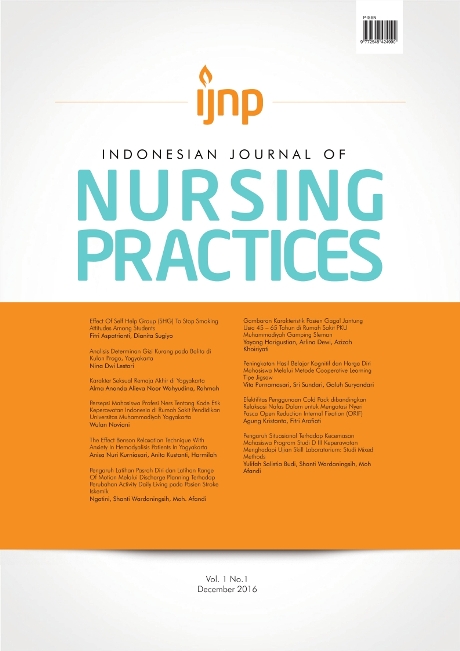PENURUNAN KECEMASAN REMAJA KORBAN BULLYING MELALUI TERAPI KOGNITIF
DOI:
https://doi.org/10.18196/ijnp.v1i2.3432Keywords:
bullying, anxiety, cognitive therapyAbstract
Bullying causes many negative impacts to the victims, one of them is anxiety. Anxiety influence learning achievement for student. Therefore, it is important to take therapy to reduce anxiety. This study aims to determine the effectiveness of cognitive therapy in reducing anxiety in adolescents’ victims of bullying. Subjects in this study were SMA’S students who are victims of bullying. The research design used True Experimental Pre-Post Test With Control Group. Sample was 22 respondents with simple random sampling technique. Researchers used Olweus Bully / Victims Questionnaire to identify students who are victims of bullying and HARS (Hamilton anxietyrating scale) (rxx '= 0.617) to identify anxiety before and after therapy. The results of this study was cognitive therapy reduce anxiety level in adolescent’s victim of bullying (p-value= 0,002). Another finding in this study, there was a difference of quantitative meetings on respondents when getting therapy, it depends on the number of negative thoughts and the ability of respondents to control negative thoughts.
References
Carney, A. G. & Merrell, K. W. (2001) Perspectives on understanding and preventing an international problem. School Psychology International, 22:364-82.
EImerbrink, Scielzo, & Campbell. (2015). The Impact of Social and Relational Victimization on Depression, Anxiety, and Loneliness: A Meta-Analytic Review. Journal of Bullying and Social Aggression. 1(1). Issn 2375-5849
Festa, C.C. &Ginsburg, G.S., (2011).Parental and Peer Predictors of Social anxiety in Youth.
Gavino, M.F. (2013). Group Therapy for adolescent bullying victims (cognitive approach). De La Salle University
Ingul, J.M, Aune, & Nordahl. (2013). A Randomized Controlled Trial of Individual Cognitive Therapy, Group Cognitive Behaviour Therapy and Attentional Placebo for Adolescent Social Phobia. Psychother Psychosom Journal 2014;83:54–61. DOI: 0.1159/000354672. Diunduh dari http://www.ncbi.nlm.nih.gov/pubmed/24281563
James, A.( 2010). School Bullying. Research Briefing
Kowalski, Robin M., & Limber, S. P. (2012). Psychological, Physical, and Academic Correlates of CyberBullying and Traditional Bullying. Journal of Adolescent Health, 53(1), S13-S20. doi: 10.1016/j.jadohealth.2012.09.018
Ling lai, Ye & Chai. (2008). Bullying in middle scool: an aisan-pasicif regional study. Asia pacific education review. 9 (4) :393-405
Liputan6. (2015). Survey ICRW. Diunduh februari 2016. http://news.liputan6.com
Olivarez, J., Sanchez- Garcia, R., Lopez-Pina, J. (2009). The liebowitz social anxiety scale for children and adolescents. Journal of Psicothema. 21 (3)
Power, D. (2010). Emotion-Focused Cognitive Therapy. John Wiley: Oxford Malden
Rivers, Ian, & Noret, N. (2012).Potential Suicide Ideation and Its Association With Observing Bullying at School. Journal of Adolescent Health, 53(1), S32-S36. doi: 10.1016/j.jadohealth.2012.10.279
Sharma, P., Charak, R., & Sharma, V. (2009). Contemporary Perspectives on Spirituality and Mental Health. Indian Journal of Psychological Medicine, 31(1), 16–23. http://doi.org/10.4103/0253-7176.53310
Smith, P. K., Mahdavi, J., Carvalho, M., Fisher, S., Russell, S. and Tippett, N. (2008) CyberBullying: Its nature and impact in secondary school pupils. Journal of Child Psychologyand Psychiatry, 49:376-385.
Stuart, G.W. (2010). Principles and practice of psychiatric nursing. 10th ed. Canada: Mosby, Inc
Torabi F, Sajjadi M, Nourian M, Borumandnia N, &Shirinabadi FA.(2016). The effects of spiritual care on anxiety in adolescents with cancer. Supportive and Palliative Care in Cancer 2016; in press.http://journals.sbmu.ac.ir/spc/article/view/11007
Downloads
Published
Issue
Section
License
License
Articles published in the IJNP (Indonesian Journal of Nursing Practices) are licensed under a Attribution 4.0 International (CC BY 4.0) license. You are free to:
- Share — copy and redistribute the material in any medium or format.
- Adapt — remix, transform, and build upon the material for any purpose, even commercially.
This license is acceptable for Free Cultural Works. The licensor cannot revoke these freedoms as long as you follow the license terms. Under the following terms:
Attribution — You must give appropriate credit, provide a link to the license, and indicate if changes were made. You may do so in any reasonable manner, but not in any way that suggests the licensor endorses you or your use.
- No additional restrictions — You may not apply legal terms or technological measures that legally restrict others from doing anything the license permits.
Copyright
Authors who publish with IJNP (Indonesian Journal of Nursing Practices) agree to the following terms:
- Authors retain copyright and grant IJNP (Indonesian Journal of Nursing Practices) the right of first publication with the work simultaneously licensed under an Attribution 4.0 International (CC BY 4.0) that allows others to remix, adapt and build upon the work with an acknowledgment of the work's authorship and of the initial publication in IJNP (Indonesian Journal of Nursing Practices).
- Authors are permitted to copy and redistribute the journal's published version of the work (e.g., post it to an institutional repository or publish it in a book), with an acknowledgment of its initial publication in IJNP (Indonesian Journal of Nursing Practices).















